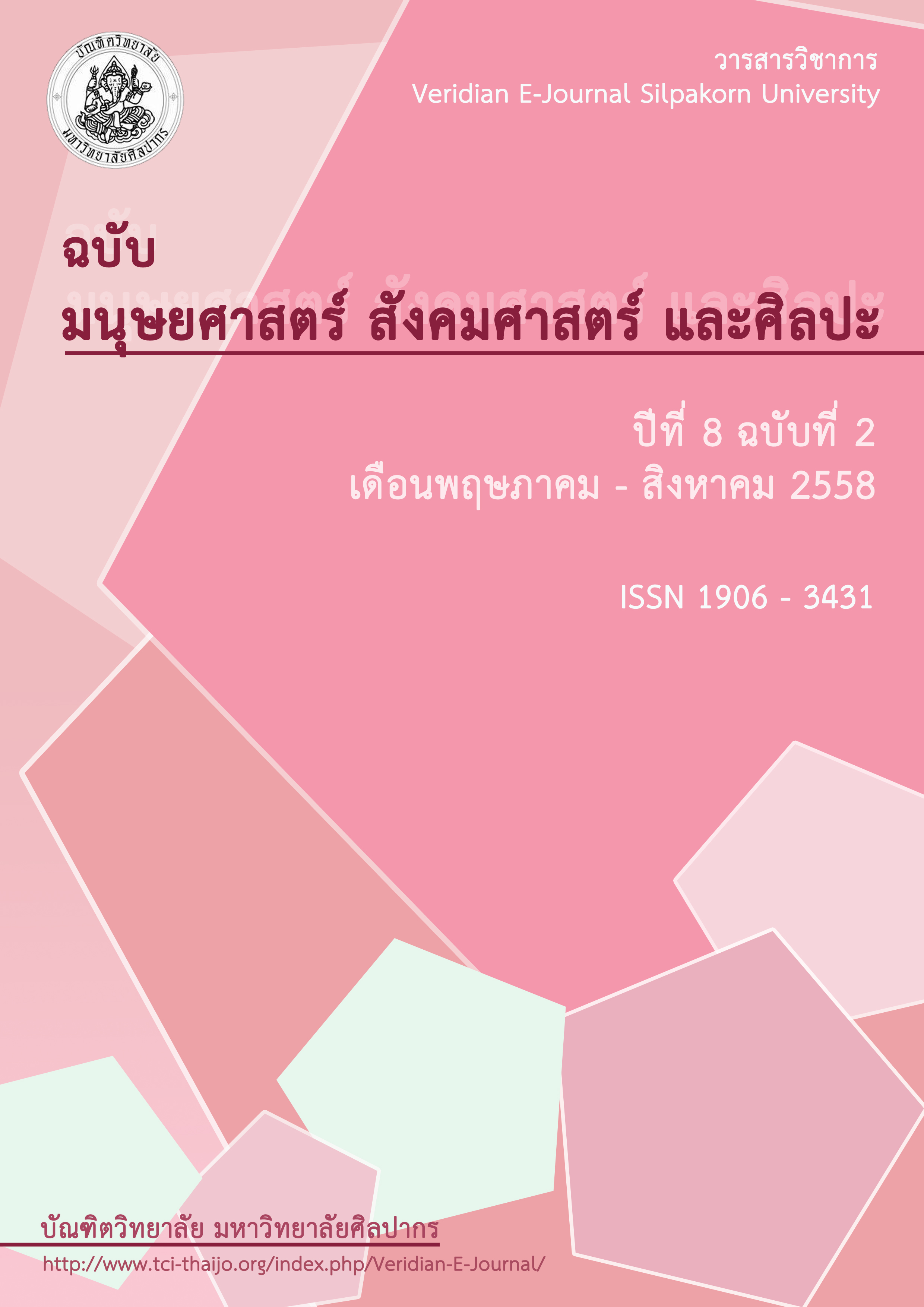“ไม่ยืดชีวิตและไม่เร่งความตาย”: การสร้างทฤษฎีฐานรากจากรูปแบบและกระบวนการจิตอาสา ดูแลผู้ป่วยระยะสุดท้าย สถาบันสุขภาพเด็กแห่งชาติมหาราชินี (รพ. เด็ก กรุงเทพมหานคร)
Main Article Content
Abstract
บทคัดย่อ
การวิจัยนี้มีวัตถุประสงค์ คือ 1) เพื่อค้นหาความหมายและทัศนะของการเป็นจิตอาสาดูแลผู้ป่วยฯ 2) เพื่อศึกษารูปแบบและกระบวนการของจิตอาสาดูแลผู้ป่วยฯ 3) เพื่อศึกษาปัญหาและอุปสรรคของจิตอาสาในการดูแลผู้ป่วยฯ และ 4) เพื่อสร้างทฤษฎีจากรูปแบบ กระบวนการ ปัญหาและอุปสรรคของจิตอาสาดูแลผู้ป่วยฯ การวิจัยนี้เป็นการวิจัยเชิงคุณภาพเพื่อหาข้อสรุปเชิงทฤษฎีจากมุมมองและทัศนะของจิตอาสาดูแลผู้ป่วยฯ กำหนดตัวอย่างเชิงทฤษฎีด้วยคุณสมบัติ คือ เป็นจิตอาสาดูแลผู้ป่วยฯ ที่สถาบันสุขภาพเด็กแห่งชาติมหาราชินี (รพ. เด็ก กรุงเทพมหานคร) มาเป็นเวลาไม่ต่ำกว่า 2 ปี ใช้แบบแผนการสุ่มตัวอย่างเป็นแบบเจาะจงและแบบสโนว์บอล จำนวน 15 คน เก็บรวบรวมข้อมูลด้วยวิธีการสัมภาษณ์ระดับลึก การสังเกต จดบันทึกและการศึกษาเอกสาร ในตอนท้ายของบทความ ได้นำเสนอข้อเสนอแนะเชิงทฤษฎี ข้อเสนอแนะในการปฏิบัติที่ได้จากผลวิจัย ตลอดจนข้อเสนอแนะสำหรับการทำวิจัยต่อไปในอนาคต
ผลการวิจัยพบว่า 1) จิตอาสาดูแลผู้ป่วยฯ ได้ให้ความหมายและทัศนะของการเป็นจิตอาสาดูแลผู้ป่วยฯ ไว้ดังนี้ ผู้ที่เปี่ยมด้วยความรักและความเห็นอกเห็นใจ ผู้ที่สละความสุขส่วนตน สละเวลาอย่างต่อเนื่อง ผู้ที่ระลึกถึงหน้าที่ของ “การไม่ยืดชีวิตและไม่เร่งความตาย” ผู้ที่อุทิศตนเพื่อลดทอนความทุกข์และตอบสนองความต้องการของผู้ป่วย และ ผู้ที่มีความมั่นใจและตั้งใจว่าจะสามารถเปลี่ยนแปลงทัศนคติของผู้ป่วยได้ 2) สามารถจำแนกจิตอาสาดูแลผู้ป่วยฯออกได้เป็น 2 รูปแบบ คือ จิตอาสาที่มีทักษะเฉพาะตัว เช่น แพทย์ พยาบาล บุคลากรทางการสาธารณสุขและจิตอาสาที่เป็นบุคคลทั่วไป แต่มีลักษณะเด่นคือยึดมั่นในอุดมการณ์ ยึดมั่นในหลักศาสนา จารีตประเพณี หรือยึดมั่นในค่านิยมบางประการ 3) การเป็นจิตอาสาดูแลผู้ป่วยฯจะต้องผ่านกระบวนการต่างๆ ที่สำคัญ ได้แก่ การสมัคร การปฐมนิเทศการอบรมสร้างความชำนาญพื้นฐานทั้งทางร่างกายและจิตใจและการลงมือปฏิบัติเยี่ยมเยียมผู้ป่วย 4) จิตอาสาดูแลผู้ป่วยฯกล่าวถึงปัญหาและอุปสรรคที่พบระหว่างทำกิจกรรม ได้แก่ มุมมองที่ต่างกัน การจัดสรรเวลา กรณีจิตอาสาไม่ได้มาเยี่ยมผู้ป่วย ผู้ป่วยไม่ตอบรับ ความผูกพันที่มากไปและจิตอาสารู้สึกว่าทำน้อยไป
คำสำคัญ: จิตอาสา, พฤติกรรมการดูแล, เด็กป่วยระยะสุดท้าย, การดูแลแบบประคับประคอง, ผู้ป่วยระยะสุดท้าย
Abstract
The objectives of this study were 1) to explore the meaning of and attitudes towards volunteer caring for terminally ill patients, 2) to investigate the models and processes of volunteer caring for terminally ill patients, 3) to identify problems and barriers of volunteer caring for terminally ill patients, and 4) to develop a grounded theory based on the models, processes, problems and barriers of volunteer caring for terminally ill patients. This study was a qualitative research to draw theoretical conclusion on volunteers’ perspective and attitude. The sample selected in this study consisted of volunteers who care for the terminally ill patients at Queen Sirikit National Institute of Child Health (Children Hospital, Bangkok) for at least 2 years. Purposive and Snowball Sampling were used as the sampling method to collect data from 15 volunteers. Data was collected through in-depth interviews, observation, note-taking, and related documents. The final section of this paper is theoretical and practical suggestions as well as suggestions for further research.
The results of this study were found that 1) the sample gave meanings of and attitudes towards volunteer caring for the terminally ill patients as follows: The volunteer caring for terminally ill patients refers to a person who is kind-hearted and compassionate, a person who sacrifices his/her own happiness and time, a person who recalls the principle of “Not prolong life and not hasten death of terminally ill patients”, a person who dedicates himself/herself to alleviate suffering and to meet the needs of terminally ill patients, and a person who is confident and determined to change the attitudes of terminally ill patients, 2) The sample volunteers in this study could be classified into two types namely, first, volunteers with professional skills such as physicians, nurses, public health workers and second, general volunteers who have adherence to a certain ideology, religious tradition, or values. To become volunteers caring for terminally ill patients, they have to pass through various processes, including the application, orientation, basic skills training, both physically and mentally and implementation through hospital visit, 4) The sample volunteers reported problems and barriers during this study including different perspectives, time allocation, absence of volunteers to visit patients, ignorance of patients , over commitment to patients, and volunteers’ tendency to underestimate their own roles.
Keywords: volunteer, caring behavior, terminally ill child, palliative care, terminally ill patients
